Endangered Species Management: Caribou versus Wolves
Over the last few months British Columbia’s controversial wolf cull has been the subject of substantial public dialogue. Like most MLAs, I receive ongoing communication from numerous British Columbians questioning the rationale behind the government’s approach. These communications crescendoed when well known singer Miley Cyrus spoke out against the cull and urged her more than 23 million followers to sign a petition. One of the recent communications I received was from a young woman named Katie. She started off her email saying:
“My name is Katie, and I oppose the wolf cull. In school we learned about predator prey relationships. I know you probably won’t care, and that the government will go ahead with it anyway, but please read this…”
I found her email to be a source of inspiration. Despite her apparent cynicism towards politicians she took the trouble to express her concerns to me (even though she is not a constituent). Her email struck a chord. I campaigned on a promise of evidence-based decision-making and giving youth in our society, the generation that will have to live the consequences of the decisions my generation is making, a voice in the legislature. And so Claire Hume and I decided to look at BC’s controversial wolf cull a little more closely. What follows is an extensive analysis of the available literature. Our analysis derived from many hours of discussions with scientists, including wildlife biologists, with expertise in the area. I look forward to your comments.
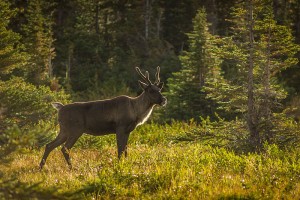 Is it justifiable to kill one animal in the name of saving another? What if one of those animals is endangered?
Is it justifiable to kill one animal in the name of saving another? What if one of those animals is endangered?
I have always maintained that humans have a moral obligation to prevent endangered species from going extinct, but wildlife management conflicts in which species are pitted against one another are always challenging. For a variety of industrial, social, or budgeting excuses, they are often situations that have been allowed to escalate far past a point of simpler intervention. When you start rationalizing culling one species to protect another you also introduce an ethical element that needs to be considered alongside scientific findings. Let one – or both – of those species become threatened or endangered and your situation becomes immensely worse.
Many ecosystems have been altered so drastically that we can no longer let nature take its course. If we don’t continue to intervene with the mountain caribou crisis we are currently facing in B.C., for example, it will not be long before the remaining herds in the South Selkirk and Peace regions are extirpated. Ideally, our wildlife management system would never let things get this bad. But it happens. And when it does we have no choice but to make tough decisions.
In January I wrote to the Minister of Forests, Lands, and Natural Resource Operations to ask a number of questions regarding the rationale for the wolf cull in the South Selkirk Mountains and the South Peace region. In response Minister Thompson sent me the supporting data that backed up their wolf cull. I read through it and agreed that with 18 caribou left we needed to take immediate and drastic action to ensure as many caribou as possible survived through another breeding season. Since then, the issue has continued to polarize our province with both sides of the debate claiming science. And in many ways, both sides are right. There is supporting evidence that suggests, for certain situations, that culling wolves is an appropriate wildlife management tool. There are also many other studies that conclude that it is an ineffective solution, one that could make the situation even worse while causing a great deal of animal suffering in the process.
So, where do we go from here? We do a literature review of the available relevant research and we have a conversation. We explore the feasibility of other options and try to find a solution that maximizes protection for threatened species while minimizing the harm done to all other animals. Over the last few months my office has been talking to scientists and analyzing data across disciplines, across species, and across the country (across continents in one case) to learn more about endangered species management.
Lessons from the Vancouver Island Marmot
In the late 1990s the Vancouver Island marmot population dropped to 70 members. While clear-cut logging in marmot territory was thought to be the initial and main reason their population numbers were plummeting, the landscape changes also led to increased predation. Between 1995 and 2005 predation by wolves, cougars, and eagles accounted for 80% of marmot mortality. Much like the caribou, habitat destruction was the main catalyst for their decline and wolves moved in to take advantage of the new open landscape. I reviewed the group’s marmot recovery plan and contacted them to ask why predator control has never been a part of their strategy.
Their Executive Director, Viki Jackson, said they tried everything they could think of on Mount Washington in place of culling predators: they collared cougars and brought dogs in to scare them away, had “shepherds” stay with the marmot colonies, put dirty human clothes around to deter predators, put up fences, and used bear bangers. Having people camp with the marmots 24/7 worked well, Jackson said, but the other attempts didn’t do much. At the same time, they started to have success with their captive breeding program. Without their active intervention the Vancouver Island marmot would have likely gone extinct years ago.
When it comes to endangered species management, Jackson said, there will never be consensus but you have to do everything in your power to protect key females when animal numbers drop to extreme lows. You need to get them over the extinction hump and stable enough that other conservation efforts have a chance to help.
While the specifics of this case do not exactly translate to the needs of larger, transient animals like caribou, I found their imaginative approach to crisis species management inspiring. Threatened species in our province are facing very modern difficulties as they try adapt to new stressors and habitats changed by development. Perhaps we should be trying to combat these challenges with equally modern and innovative solutions before defaulting to predator culling, a practice that only targets one aspect of highly complex situations. With this thought I contacted Dr. Adam Ford from the University of Guelph’s Department of Integrative Biology to talk about the use of technology in wildlife research and management.
GPS Management
Global Positioning Systems (GPS) placed on collars, Dr. Adam Ford explained, can be used to pinpoint, with high accuracy, the location of an animal at a given time. It is also possible to track animals and process data almost instantaneously. Knopff and his colleagues, for example, used GPS to track cougar predation to study predator/prey interactions with immediate data retrieval. “Real time monitoring has enormous potential in the fields of wildlife ecology and conservation, especially for at-risk wildlife,” their report states.
With these systems you can monitor the spatial relationship between an animal and a wide variety of geographical features. Data can be collected that orients an animal in relation to specific points (like feeding grounds), linear features (roads, fence lines, fishing nets, etc.) and spatially dynamic features (like a mobile herd of livestock). Given these tracking advancements, and the incredible success scientist and conservation officers have had using them in wildlife management settings, it is hard not to feel hopeful imagining the great potential for their use with woodland caribou in BC. I think it would be worth assessing, for example, the feasibility of attaching GPS’ to select members of threatened caribou herds and their neighbouring wolf packs, as suggested by Dr. Ford. You could outfit caribou and wolves with GPS collars, Dr. Ford explained, and program them with a GSM-linked messaging system that warns managers when wolves, say, are within 1 km of the caribou. The managers could then travel to the coordinates shown in the GSM message, and herd the wolves away with aversive conditioning. That way, intervention is case-specific and the helicopter time is used much more efficiently. They use this method in Kenya with elephants to keep them away from crop fields and refer to it as ‘geofencing‘.
I appreciate comparing elephants to caribou sounds dangerously like an apples-to-oranges tangent, but the success the Save the Elephants organization has had with GPS-based wildlife management is incredible and certainly worth further consideration. Their Geo-fencing program started ten years ago, in the hopes of reducing human-elephant conflicts. “Kimani was the first elephant to be collared and tested under the Geofencing [system]. He became the focus of the Ol Pejeta management due to his considerable skill in breaking expensive fences. In December 2005 he went on a crop-raiding spree that lasted 21 straight nights.”
In phase one of the project they programmed a virtual fence line (or string of coordinates) into the GPS collar worn by the elephant. If the elephant strays out of his designated range – suggesting he is heading towards farms or villages – his collar sends a text message with his exact location to the reserve managers, who can then mobilize and intervene with negative reinforcements before he does too much damage. After only a few months in his GPS collar, Kimani the elephant had stopped breaking fences. Years later, Kimani has still not returned to his crop-stomping ways.
Another breakthrough, which does not relate to caribou but highlights the brilliant potential for innovative wildlife management strategies, was their elephants and bees hypothesis. “Having found that elephants run from the sound of bees, in 2007, we set up a unique beehive fence line in the area to see if they would deter elephants from raiding crops. To test our hypotheses, we geo-fenced several known crop-raiding elephants to see if their behaviour changed once confronted with large concentration of bees. Thanks to the geo-fencing technology, we were able to witness and confirm that bees did in fact deter elephants from crop raiding.”
Elephant-caribou differences aside, the technology is transferable. “The real-time monitoring algorithms presented here for monitoring African elephants (proximity, geo-fencing, movement rate, and immobility) are widely adaptable and applicable to monitor a variety of behaviours across numerous species,” wrote Wall et al.
While there is considerable consensus within the scientific community about the effective use of technology in wildlife management, I have found concerning disagreement about the role of wolves in caribou declines and the impact of culling them. What follows is a literature review of sorts, of the relevant research that has been done on this subject.
Wolf Cull Literature Review
Apps et al. studied the GPS, very high frequency (VHF), and motion sensor data collected from 541 caribou over 22 years. When the collared animals stopped moving for prolonged periods researchers tracked their location and tried to determine the caribou’s cause of death. In their cause-specific mortality analysis of mountain caribou in B.C. they found that wolves are only one of many important sources of mortality for caribou. The data, though limited, indicates that wolves are not necessarily the primary killer of mountain caribou. In fact, it is possible that bears and cougars may have a stronger impact on caribou numbers. That said, I spoke to Dr. Clayton Apps about his study and he cautioned that the data should not generalized too broadly as it pertains to specific sampling cases. The wider conclusion of his work focused on caribou vulnerability as it relates to landscape changes. Wolf predation was found to be concentrated at lower elevations and areas with a higher concentration of roads, which they used as a navigational advantage when hunting.
On a similar theme, DeCesare’s data links industrial development with increased encounters between wolves and caribou, which in turn can lead to increased predation. Supporting that notion, other studies have illustrated the considerable impact wolves can have on local ungulate populations. Kortello et al. conducted a study that analyzed the diet and spatial overlap between wolves and cougars in Banff National Park. During their research they observed a 65% decline in local elk populations following the arrival of wolves. This shift caused cougars to switch from a primarily elk winter diet to one that favoured deer and other alternative prey options.
At this point we have a fairly clear picture of a wolf – caribou relationship that has been knocked out of whack in areas that have been altered by industrial development. Wolves eat caribou, even more so when roads and cleared forests give wolves efficient access to a larger range while simultaneously limiting caribou’s own food sources. If we have too few caribou, and too many wolves, it is easy to conclude a wolf cull would be an appropriate response. Some short term studies support that assumption. Bergerud et al. for example suggested that a wolf cull in Northern B.C. and the Yukon lead to increases in ungulate populations, but many studies do not.
In an incredibly comprehensive and long term study, Wielgus et al. assessed the effects of a wolf cull on reducing livestock depredations in Idaho, Montana and Wyoming from 1987–2012 using a 25 year time series. The number of livestock depredated, livestock populations, wolf population estimates, number of breeding pairs, and wolves killed were calculated for the wolf-occupied area of each state for each year. Unsurprisingly, their results describe a positive association between the number of cattle in a given area, the number of cattle killed, and the number of breeding wolf pairs. In other words, as you increase the number of cows and wolves in a given area, instances of wolf-cow conflict will also rise. Incredibly, however, their data also shows a positive, not negative, association with the number of wolves culled the previous year – meaning culling wolves actually led to more livestock being killed by wolves the following year. “The odds of livestock depredations increased 4% for sheep and 5-6% for cattle with increased wolf control” (graphed in Figure 1.). Wielgus et al., hypothesized that livestock depredation increased when wolves were killed because the cull disrupted pack structures, which in turn, lead to a compensatory increase in breeding pairs, more pups, and more hunting (Figure 2.). This trend was consistent until 25% of the breeding wolf pairs had been culled, after which point livestock predations began to decline from its elevated state (graphed in Figure 3.). As the paper stresses, however, “mortality rates exceeding 25% are unsustainable over the long term.” As you can see in Figure 3., to get to the livestock mortality rate that you started with before the wolf cull elevated depredation levels, you would need to kill over 40% of the breeding wolf pairs. Ultimately, Wielgus et al. concluded that their results do not support the ‘remedial control’ hypothesis of predator mortality which predicts a drop in livestock following increased lethal control. “However,” they write, “lethal control of wolves appears to be related to increased depredation in a larger area the following year.”
Figure 1: Wolves killed versus cattle depredated: The number of wolves culled the previous year plotted against the number of cattle killed by wolves the following year. The black line indicates that as more wolves were killed through control methods, the remaining wolves killed an increased number of cattle. The dashed lines show the upper and lower limits of the 95% confidence interval for the best fit line.
Figure 2: Number of breeding wolf pairs versus cattle depredated: The number of breeding wolf pairs present in a region the previous year plotted against the number of cattle killed by wolves the following year. The black line indicates that as the number of breeding wolf pairs increases, so to does the number of cattle they kill. The dashed lines show the upper and lower limits of the 95% confidence interval for the best fit line.
Figure 3: The proportions of wolves killed versus cattle depredated: The proportion of wolves killed the previous year versus the number of cattle killed by wolves the following year. The black line indicates a 2-way negative interaction. Cattle depredation increased with increasing mortality up until roughly 25% of the wolf population was culled, then the number of cattle killed began to decline.
Echoing their conclusion from a different research angle, Brainerd et al. analyzed pooled data from 148 territorial breeding wolves and found increased movement and dispersal of wolves when the pack’s breeding (alpha) pair was removed. In other words, when you kill the alpha wolf pair who keep the rest of the pack in line, remaining wolves are statistically likely to breed more and spread into new territories. This disruption to the ecosystem is likely to trigger other changes and lead to issues to neighbouring environments.
Similarly, Treves et al. found that the removal of carnivores generally only achieves a temporary reduction in livestock depredation before other predators move in to fill their space and eat their prey. Harper et al. also found that killing a large number of wolves in Minnesota did not reduce the following year’s livestock depredation levels. They did notice, however, that a mere increase in human activity decreased the amount of hunting wolves did in the area.
Caribou Health
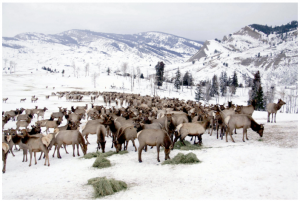
Credit: Mark Gocke, Wyoming Game and Fish
Unfortunately, there is yet another layer of concern to add to this complex analysis; caribou health. The University of Alberta’s Center for Conservation Biology began studying this issue after the government of Alberta announced plans to cull up to 80% of wolves in the oil sands in the hopes that it would slow the rate of caribou decline. They conducted dietary analyses had found that 60% of the caribou winter diet consisted of lichen. “This food source is particularly vital to pregnant caribou as it is high in glucose, which is the primary food source to the fetus,” they wrote. If female caribou do not have adequate access to lichen, they explained, it compromises their pregnancies and lowers birth rates.
“They [the government of Alberta] argue that climate change and habitat disturbance are causing deer, the preferred prey of wolves, to move north into the oil sands. Wolves are said to increase in response, increasing the risk of predation on caribou. Our work suggests that there may be better options.”
The conservation biologists suggested that reducing human and industrial activities in lichen rich feeding grounds may be a more effective mitigation strategy than killing wolves.
“Moreover,” they continued, “owing to the preference of wolves for deer, removing wolves from the population to protect caribou could actually place the ecosystem at markedly greater risk by accelerating the expansion of deer into this ecosystem.”
The Columbia Mountains Institute of Applied Ecology has picked up on this theme too. “Caribou decline may be related to too much energy spent on just trying to stay alive,” explained national park warden John Flaa. “Over the past summer, the three caribou mortalities I investigated had no body fat, which is bound to have an effect on calf production. Census results here show that the proportion of calves in the herd are below replacement level.”
Accessing an adequate food supply has been an ongoing issue for elk too, especially across the border in Wyoming. Their Game and Fish Wildlife Division, however, has managed to greatly inflate herd size over the last few decades by feeding them hay every winter. Not surprisingly, issues of disease began to increase as more elk congregated at feeding grounds. As Creech et al. explained; “High seroprevalance for Brucella abortus among elk on Wyoming feedgrounds suggests that supplemental feeding may influence parasite transmission and disease dynamics by altering the rate at which elk contact infectious materials in their environment.” Thankfully, they have also since shown that spreading out feeding areas reduces cross contamination infection rates by 70%.
This is not an ideal solution, of course, but it has been quite successful in many respects. Elk populations in Wyoming are now strong enough to support hunting, an activity that more than covers the cost of the feeding program. “Elk hunters spent $49.9 million in 2012… The program cost $558 per animal and generated $1,856 in ‘economic return’ per [elk].”
Conclusion
As Dr. Adam Ford wrote in his summary paper Science, Uncertainty, and Ethics in the Alberta Wolf Cull; “It is past time that we adopt a more creative view of how we can coexist with caribou and wolves in an industrialized landscape.” After reviewing the literature available on this and related issues I agree. While this is an undeniably complex situation with a lot at stake, I think we should be doing more to learn from innovative wildlife managers around the world.
We could try creating a geo-fence between wolves and threatened caribou like conservation officers do with their problem elephants in Kenya. Or get ‘caribou shepherds’ to track GPS collared herds, intervening when they are at risk of predation; much like the ‘marmot shepherds’ who saved endangered (admittedly easier to track) colonies on Vancouver Island. We could explore the feasibility of capturing, sterilizing, and re-releasing the alpha breeding pair in a pack of wolves; thereby reducing the growth of a wolf population while keeping the governing pack structure in place. Given the above concerns about food availability for caribou, as well as the effective use of feed lots elsewhere, I think we should also consider supplementing the diets of the South Selkirk and Peace region herds with a stable supply of lichen over the winter. It would be a relatively cost effective, simple, and could potentially be game-changing for our struggling caribou.
Some of these solutions may sound crazy, but when you consider we are currently spending millions of dollars to indiscriminately shoot wolves from helicopters, I would argue they potentially offer for more cheaper and less-crazy alternatives.
Acknowlegements
We are sincerely grateful to the many scientists who made time to talk to us about their work.

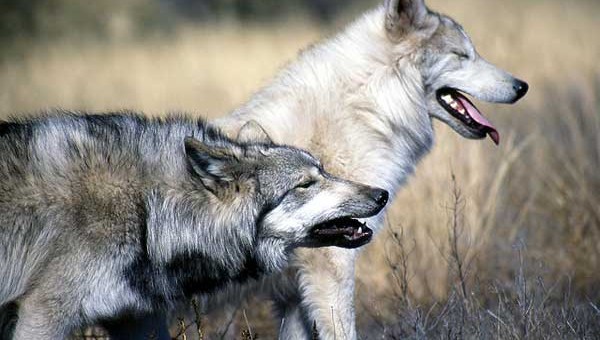
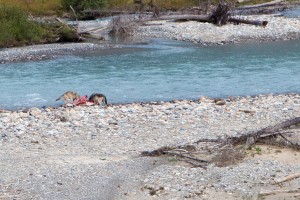
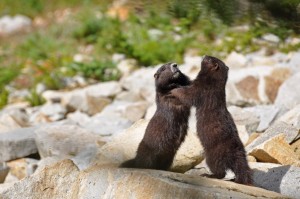
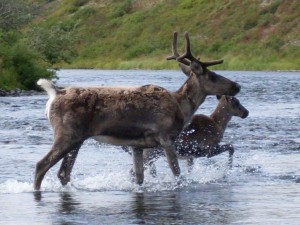
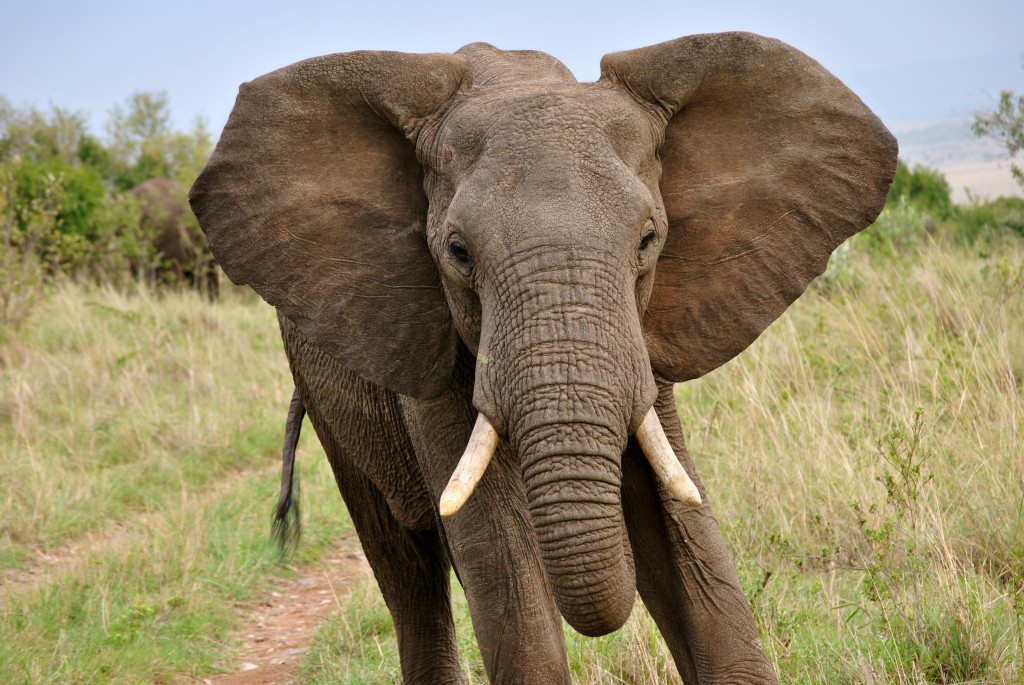
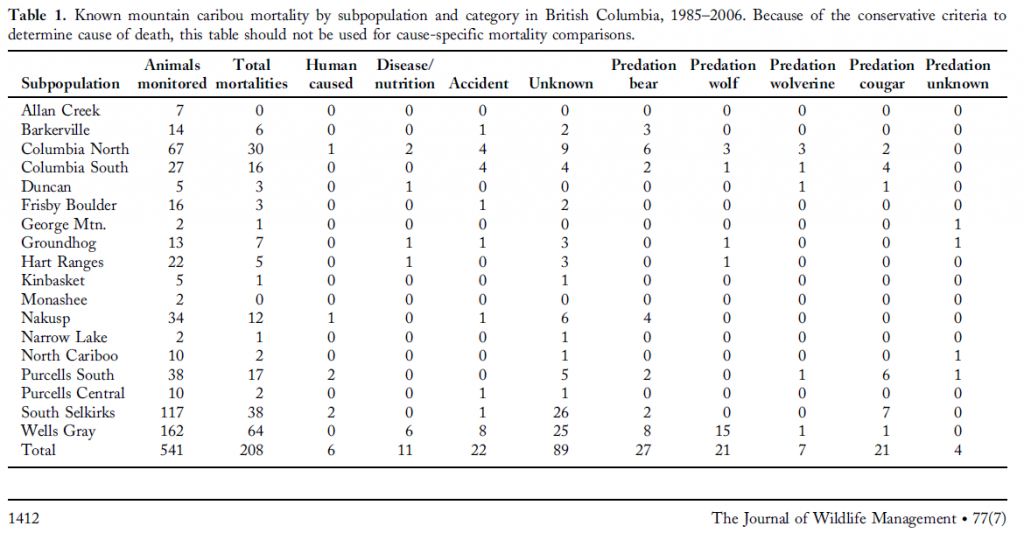
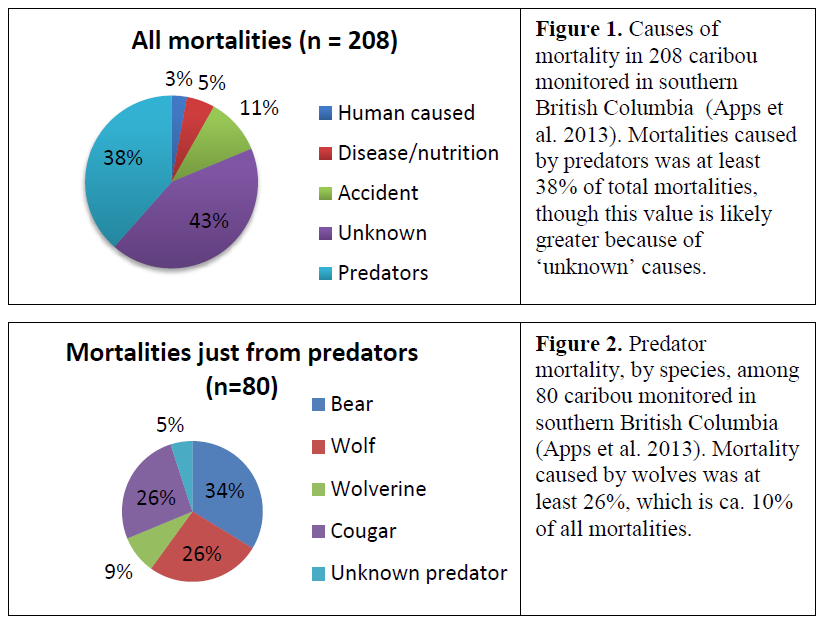
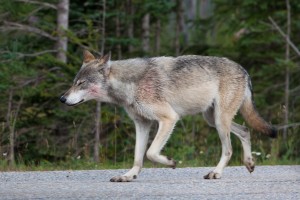
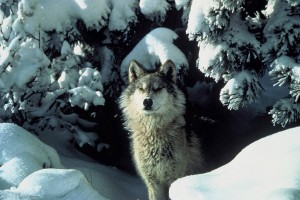
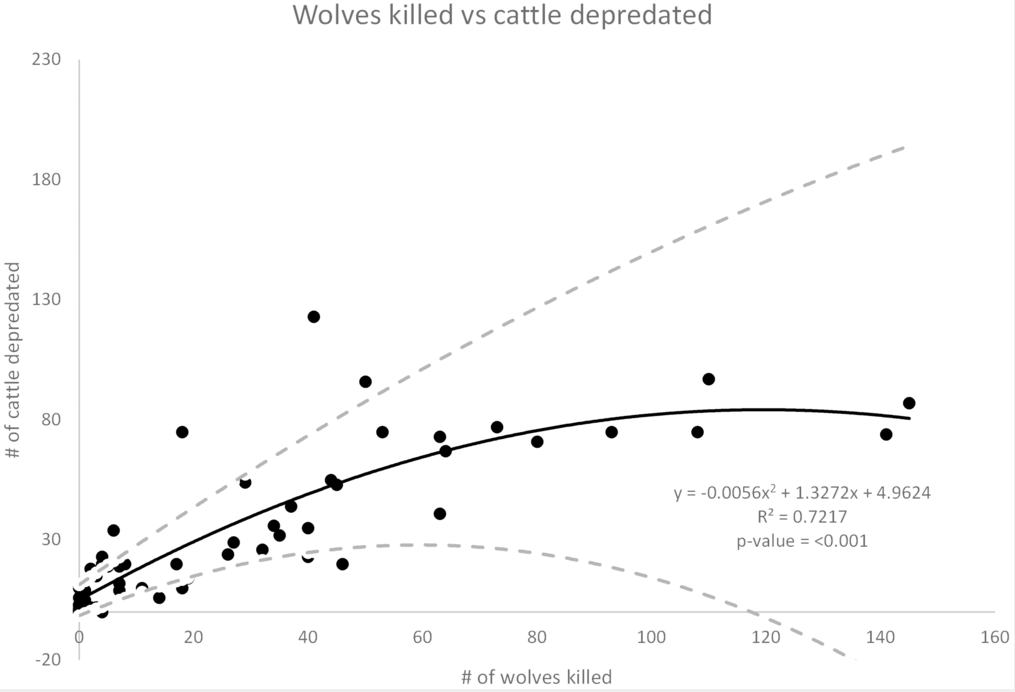
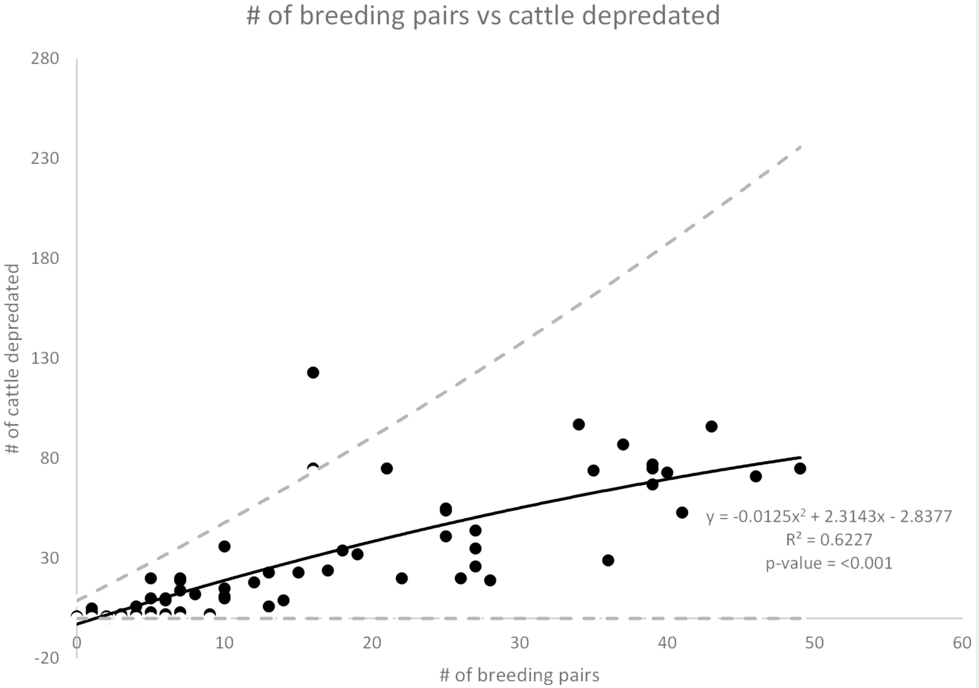
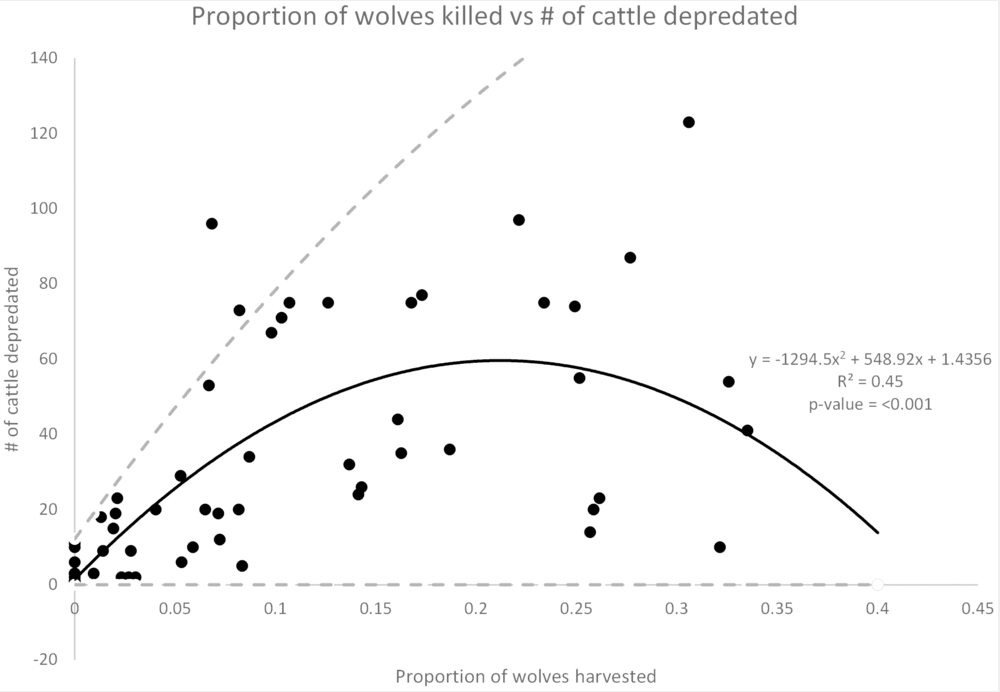
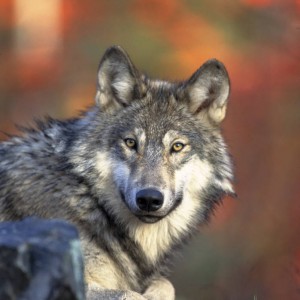
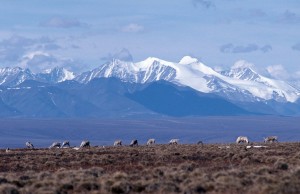



7 Comments
The full quote from Ford’s paper is more comprehensive than the abbreviated version chosen. The full quote reads:
“After six years, it is not clear that wolf culling achieved its desired management goal. In fact, risk to caribou may have actually increased. …
It is past time that we adopt a more creative view of how we can coexist with caribou and wolves in an industrialized landscape.”
I commend the scientific zealousness of ecological protections.
We don’t want to be another Australia and sacrifice one species over another.
Let Christy and “friends” go target shooting instead!
The rate of mortalities by predators was 38%. Another 43% of deaths were caused by *unknown* factors. It does *not* follow that these unknown factors are also predator mortalities. This is pure speculation. These causes are as stated: unknown. Also – of the monitored caribou populations, significantly more animals are predated by bears. So, what then, is the rationale for focusing on wolves? There are SO many holes in this science. Wolves are simply being persecuted, and provincial FOI documents show that the government is simply capitulating to industry, which does not wish to forego harvests. (http://www.theglobeandmail.com/news/british-columbia/documents-indicate-bc-wolf-cull-linked-to-forest-industry-concerns/article26968437/) The same FOI package also shows that the provincial government appears to regard its legal obligations to the federal government, which oblige the province to protect habitats for species at risk, as “science advice” rather than the legal obligations as they exist. In my opinion, this rhetoric – however pseudo-scientific – in support of a cull aimed at capitulating to industry over the interests of species at risk, and at the expense of wolves (or other species) needs to be reexamined. Also in my view: supporting wolf culls at the behest of industry, using pseudo-science, is unethical.
It is encouraging to see a serious analysis of the problem instead of the usual hysteria. I hope Christy Clark’s government is open to alternatives, because its guns blazing approach is damaging B.C.’s reputation internationally and not doing much to save caribou.
recent article just out on this…
http://www.theglobeandmail.com/news/british-columbia/documents-indicate-bc-wolf-cull-linked-to-forest-industry-concerns/article26968437/
I find the analysis heavily ladled with terminology that smacks of a fragmented understanding of the unfolding tragedy of a wolf cull on a landscape no longer able to connect the wild places: therefore, applying any seemingly cogent plan based upon the data sets considered (superficially, arbitrary, in that selective data was isolated from the bigger picture), the pro wolf cull supporters represent more than self interest and stand to economically benefit,) Little data reflected the reality and impacts of a snowmobile culture and back country ski culture, stressing and pushing caribou out of environments which they know and could survive. Not buying your support, or your convoluted science!
I agree with Dr. Adam Ford’s approaches to save the 18 caribou left and enable the herd to grow.